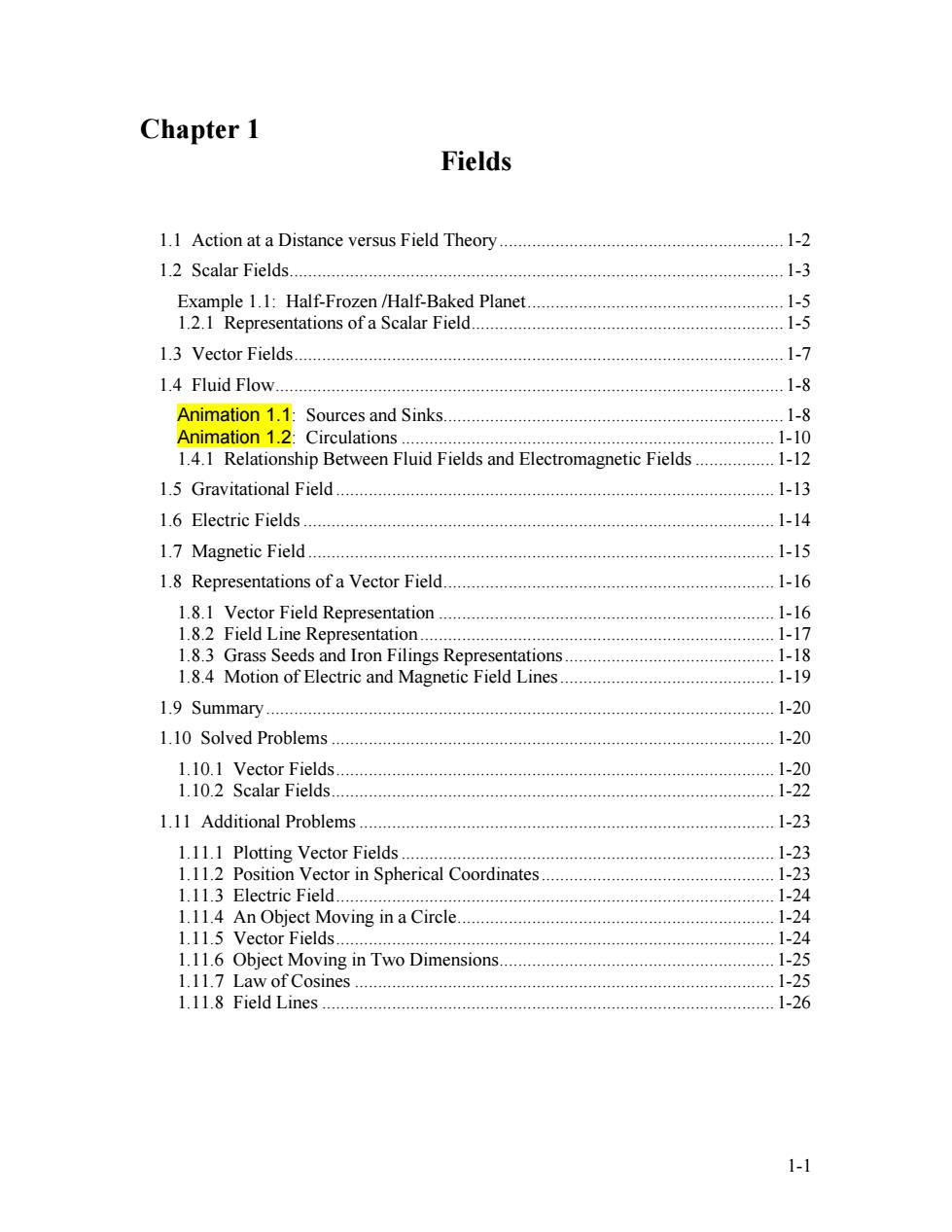
Chapter 1 Fields 1.1 Action at a Distance versus Field Theory 1-2 1.2 Scalar Fields 1-3 Example 1.1:Half-Frozen/Half-Baked Planet... 1-5 1.2.1 Representations of a Scalar Field...... 1-5 1.3 Vector Fields. .1-7 1.4 Fluid Flow.… 1-8 Animation 1.1:Sources and Sinks.............. .1-8 Animation 1.2:Circulations........ .1-10 1.4.1 Relationship Between Fluid Fields and Electromagnetic Fields ...1-12 1.5 Gravitational Field................... .1-13 1.6 Electric Fields....... .1-14 1.7 Magnetic Field .1-15 1.8 Representations of a Vector Field.... 1-16 1.8.1 Vector Field Representation.......... .1-16 1.8.2 Field Line Representation....... .1-17 1.8.3 Grass Seeds and Iron Filings Representations .1-18 1.8.4 Motion of Electric and Magnetic Field Lines. .1-19 1.9 Summary.… 1-20 1.10 Solved Problems.............. .1-20 l.10.1 Vector Fields.… .1-20 1.l0.2 Scalar Fields… .1-22 1.11 Additional Problems. 1-23 1.11.1 Plotting Vector Fields.... .1-23 1.11.2 Position Vector in Spherical Coordinates.............................1-23 1.11.3 Electric Field.......... .1-24 1.11.4 An Object Moving in a Circle 1-24 l.1l.5 Vector Fields… 1-24 1.11.6 Object Moving in Two Dimensions 1-25 1.11.7 Law of Cosines.............. 1-25 1.11.8 Field Lines............. 1-26 1-1
Chapter 1 Fields 1.1 Action at a Distance versus Field Theory.............................................................1-2 1.2 Scalar Fields..........................................................................................................1-3 Example 1.1: Half-Frozen /Half-Baked Planet.......................................................1-5 1.2.1 Representations of a Scalar Field...................................................................1-5 1.3 Vector Fields.........................................................................................................1-7 1.4 Fluid Flow.............................................................................................................1-8 Animation 1.1: Sources and Sinks.........................................................................1-8 Animation 1.2: Circulations ................................................................................1-10 1.4.1 Relationship Between Fluid Fields and Electromagnetic Fields.................1-12 1.5 Gravitational Field ..............................................................................................1-13 1.6 Electric Fields.....................................................................................................1-14 1.7 Magnetic Field ....................................................................................................1-15 1.8 Representations of a Vector Field.......................................................................1-16 1.8.1 Vector Field Representation ........................................................................1-16 1.8.2 Field Line Representation............................................................................1-17 1.8.3 Grass Seeds and Iron Filings Representations.............................................1-18 1.8.4 Motion of Electric and Magnetic Field Lines..............................................1-19 1.9 Summary.............................................................................................................1-20 1.10 Solved Problems ...............................................................................................1-20 1.10.1 Vector Fields..............................................................................................1-20 1.10.2 Scalar Fields...............................................................................................1-22 1.11 Additional Problems.........................................................................................1-23 1.11.1 Plotting Vector Fields................................................................................1-23 1.11.2 Position Vector in Spherical Coordinates..................................................1-23 1.11.3 Electric Field..............................................................................................1-24 1.11.4 An Object Moving in a Circle....................................................................1-24 1.11.5 Vector Fields..............................................................................................1-24 1.11.6 Object Moving in Two Dimensions...........................................................1-25 1.11.7 Law of Cosines ..........................................................................................1-25 1.11.8 Field Lines .................................................................................................1-26 1-1
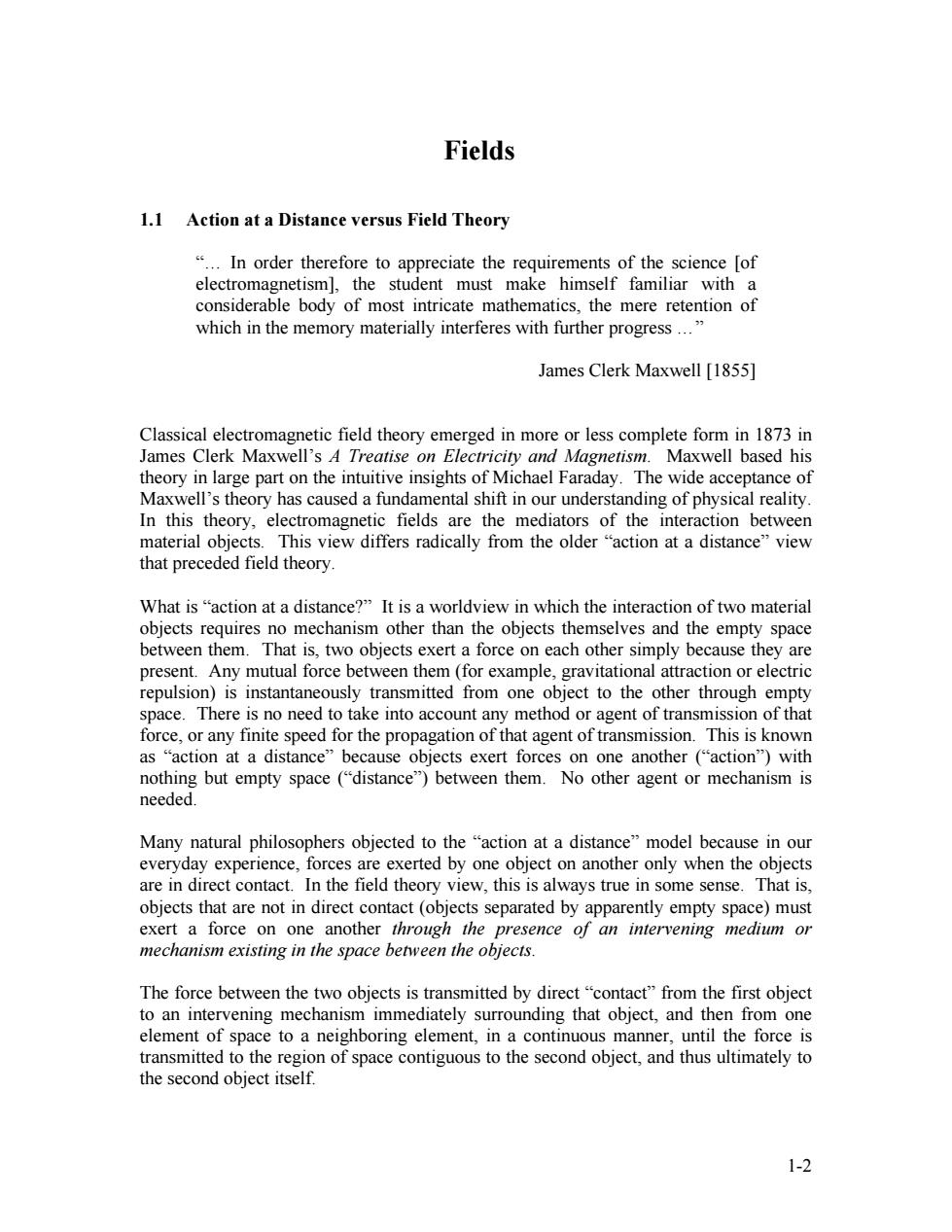
Fields 1.1 Action at a Distance versus Field Theory ....In order therefore to appreciate the requirements of the science [of electromagnetism],the student must make himself familiar with a considerable body of most intricate mathematics,the mere retention of which in the memory materially interferes with further progress..." James Clerk Maxwell [1855] Classical electromagnetic field theory emerged in more or less complete form in 1873 in James Clerk Maxwell's A Treatise on Electricity and Magnetism.Maxwell based his theory in large part on the intuitive insights of Michael Faraday.The wide acceptance of Maxwell's theory has caused a fundamental shift in our understanding of physical reality. In this theory,electromagnetic fields are the mediators of the interaction between material objects.This view differs radically from the older "action at a distance"view that preceded field theory. What is"action at a distance?"It is a worldview in which the interaction of two material objects requires no mechanism other than the objects themselves and the empty space between them.That is,two objects exert a force on each other simply because they are present.Any mutual force between them(for example,gravitational attraction or electric repulsion)is instantaneously transmitted from one object to the other through empty space.There is no need to take into account any method or agent of transmission of that force,or any finite speed for the propagation of that agent of transmission.This is known as "action at a distance"because objects exert forces on one another ("action")with nothing but empty space ("distance")between them.No other agent or mechanism is needed. Many natural philosophers objected to the "action at a distance"model because in our everyday experience,forces are exerted by one object on another only when the objects are in direct contact.In the field theory view,this is always true in some sense.That is, objects that are not in direct contact (objects separated by apparently empty space)must exert a force on one another through the presence of an intervening medium or mechanism existing in the space between the objects. The force between the two objects is transmitted by direct "contact"from the first object to an intervening mechanism immediately surrounding that object,and then from one element of space to a neighboring element,in a continuous manner,until the force is transmitted to the region of space contiguous to the second object,and thus ultimately to the second object itself. 1-2
Fields 1.1 Action at a Distance versus Field Theory “… In order therefore to appreciate the requirements of the science [of electromagnetism], the student must make himself familiar with a considerable body of most intricate mathematics, the mere retention of which in the memory materially interferes with further progress …” James Clerk Maxwell [1855] Classical electromagnetic field theory emerged in more or less complete form in 1873 in James Clerk Maxwell’s A Treatise on Electricity and Magnetism. Maxwell based his theory in large part on the intuitive insights of Michael Faraday. The wide acceptance of Maxwell’s theory has caused a fundamental shift in our understanding of physical reality. In this theory, electromagnetic fields are the mediators of the interaction between material objects. This view differs radically from the older “action at a distance” view that preceded field theory. What is “action at a distance?” It is a worldview in which the interaction of two material objects requires no mechanism other than the objects themselves and the empty space between them. That is, two objects exert a force on each other simply because they are present. Any mutual force between them (for example, gravitational attraction or electric repulsion) is instantaneously transmitted from one object to the other through empty space. There is no need to take into account any method or agent of transmission of that force, or any finite speed for the propagation of that agent of transmission. This is known as “action at a distance” because objects exert forces on one another (“action”) with nothing but empty space (“distance”) between them. No other agent or mechanism is needed. Many natural philosophers objected to the “action at a distance” model because in our everyday experience, forces are exerted by one object on another only when the objects are in direct contact. In the field theory view, this is always true in some sense. That is, objects that are not in direct contact (objects separated by apparently empty space) must exert a force on one another through the presence of an intervening medium or mechanism existing in the space between the objects. The force between the two objects is transmitted by direct “contact” from the first object to an intervening mechanism immediately surrounding that object, and then from one element of space to a neighboring element, in a continuous manner, until the force is transmitted to the region of space contiguous to the second object, and thus ultimately to the second object itself. 1-2
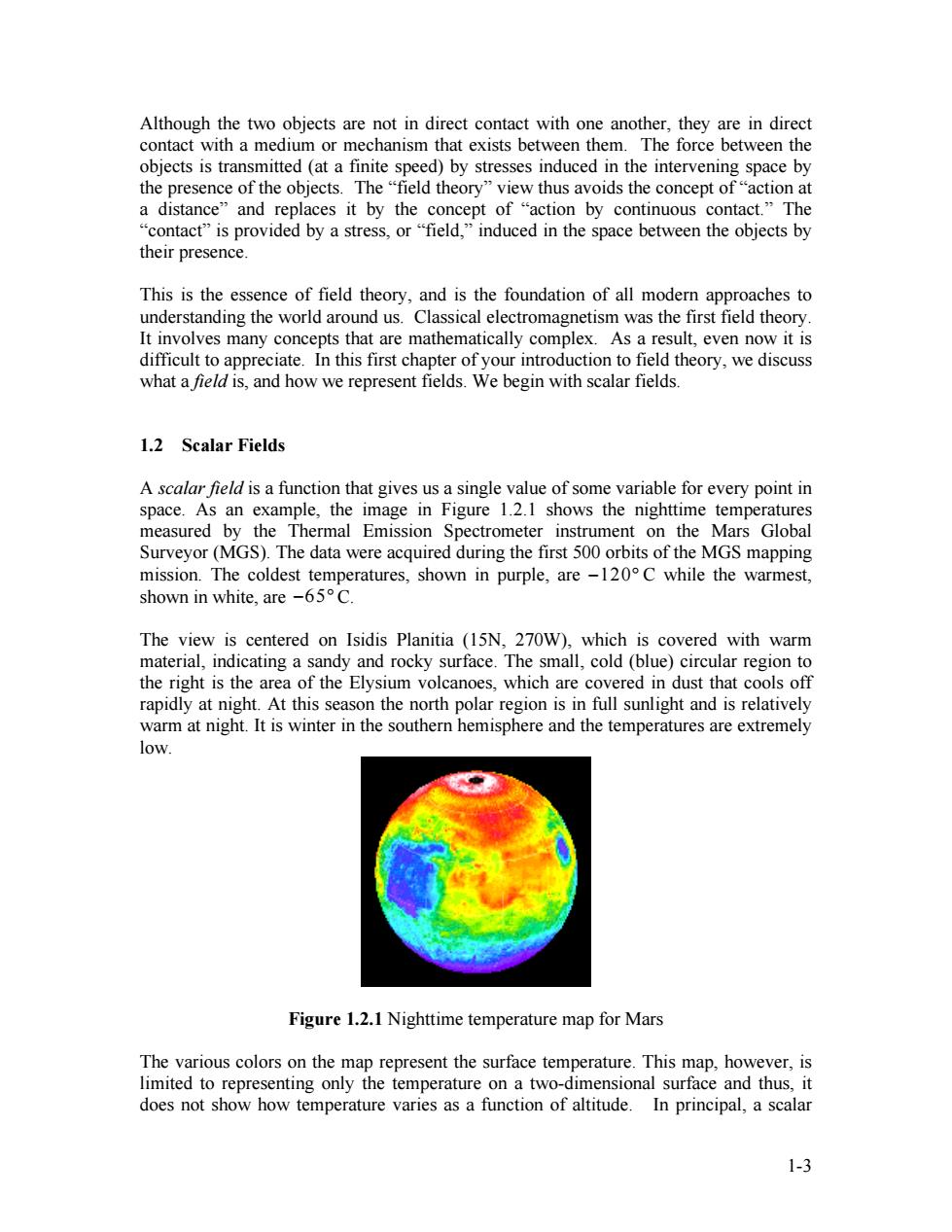
Although the two objects are not in direct contact with one another,they are in direct contact with a medium or mechanism that exists between them.The force between the objects is transmitted (at a finite speed)by stresses induced in the intervening space by the presence of the objects.The "field theory"view thus avoids the concept of"action at a distance"and replaces it by the concept of "action by continuous contact."The "contact"is provided by a stress,or "field,"induced in the space between the objects by their presence. This is the essence of field theory,and is the foundation of all modern approaches to understanding the world around us.Classical electromagnetism was the first field theory. It involves many concepts that are mathematically complex.As a result,even now it is difficult to appreciate.In this first chapter of your introduction to field theory,we discuss what a field is,and how we represent fields.We begin with scalar fields. 1.2 Scalar Fields A scalar field is a function that gives us a single value of some variable for every point in space.As an example,the image in Figure 1.2.1 shows the nighttime temperatures measured by the Thermal Emission Spectrometer instrument on the Mars Global Surveyor(MGS).The data were acquired during the first 500 orbits of the MGS mapping mission.The coldest temperatures,shown in purple,are -120C while the warmest, shown in white,are -65C. The view is centered on Isidis Planitia (15N,270W),which is covered with warm material,indicating a sandy and rocky surface.The small,cold (blue)circular region to the right is the area of the Elysium volcanoes,which are covered in dust that cools off rapidly at night.At this season the north polar region is in full sunlight and is relatively warm at night.It is winter in the southern hemisphere and the temperatures are extremely low. Figure 1.2.1 Nighttime temperature map for Mars The various colors on the map represent the surface temperature.This map,however,is limited to representing only the temperature on a two-dimensional surface and thus,it does not show how temperature varies as a function of altitude.In principal,a scalar 1-3
1-3 Although the two objects are not in direct contact with one another, they are in direct contact with a medium or mechanism that exists between them. The force between the objects is transmitted (at a finite speed) by stresses induced in the intervening space by the presence of the objects. The “field theory” view thus avoids the concept of “action at a distance” and replaces it by the concept of “action by continuous contact.” The “contact” is provided by a stress, or “field,” induced in the space between the objects by their presence. This is the essence of field theory, and is the foundation of all modern approaches to understanding the world around us. Classical electromagnetism was the first field theory. It involves many concepts that are mathematically complex. As a result, even now it is difficult to appreciate. In this first chapter of your introduction to field theory, we discuss what a field is, and how we represent fields. We begin with scalar fields. 1.2 Scalar Fields A scalar field is a function that gives us a single value of some variable for every point in space. As an example, the image in Figure 1.2.1 shows the nighttime temperatures measured by the Thermal Emission Spectrometer instrument on the Mars Global Surveyor (MGS). The data were acquired during the first 500 orbits of the MGS mapping mission. The coldest temperatures, shown in purple, are −120° C while the warmest, shown in white, are − ° 65 C. The view is centered on Isidis Planitia (15N, 270W), which is covered with warm material, indicating a sandy and rocky surface. The small, cold (blue) circular region to the right is the area of the Elysium volcanoes, which are covered in dust that cools off rapidly at night. At this season the north polar region is in full sunlight and is relatively warm at night. It is winter in the southern hemisphere and the temperatures are extremely low. Figure 1.2.1 Nighttime temperature map for Mars The various colors on the map represent the surface temperature. This map, however, is limited to representing only the temperature on a two-dimensional surface and thus, it does not show how temperature varies as a function of altitude. In principal, a scalar
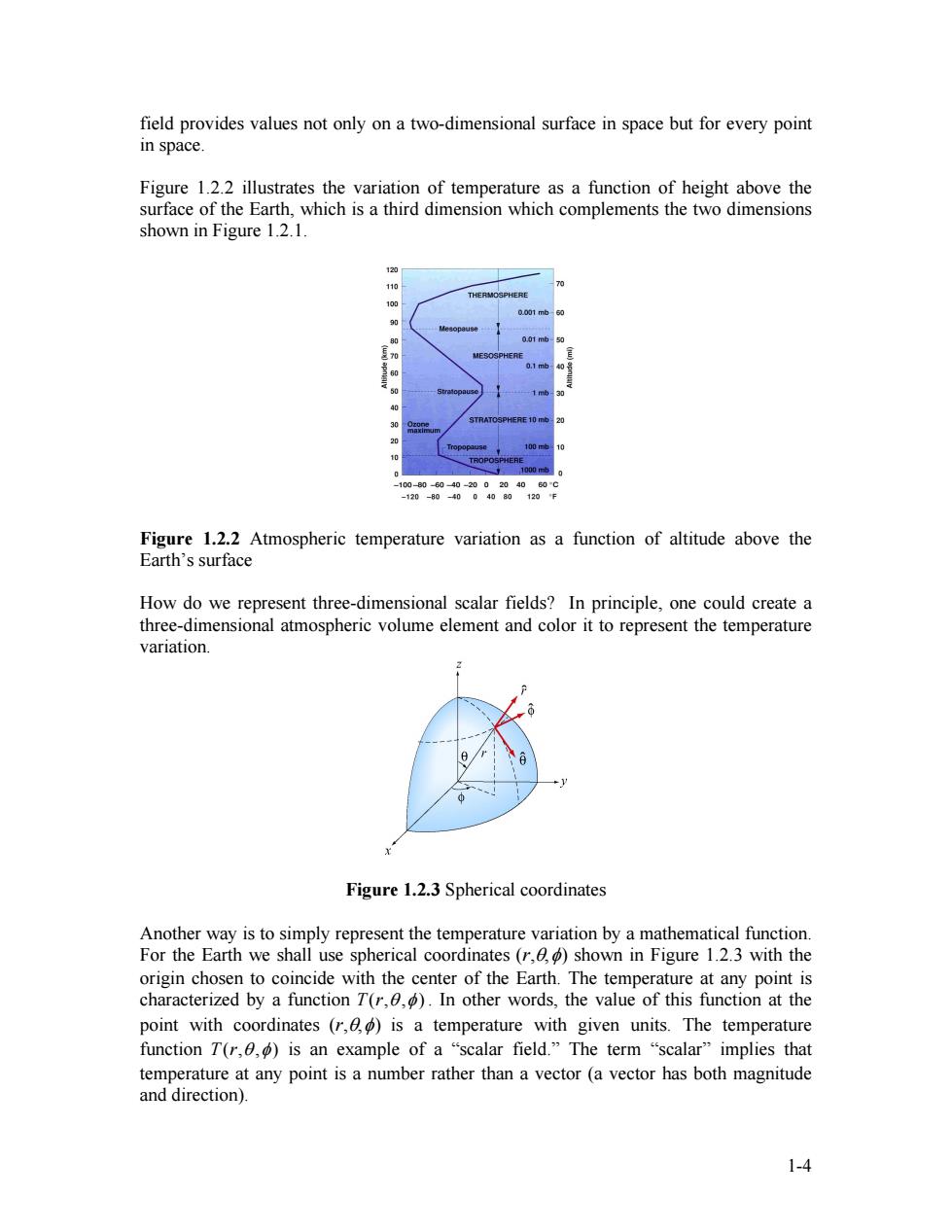
field provides values not only on a two-dimensional surface in space but for every point in space. Figure 1.2.2 illustrates the variation of temperature as a function of height above the surface of the Earth,which is a third dimension which complements the two dimensions shown in Figure 1.2.1. 0001m 40 30 20 100 10 10000 -1008060402002040600 -120 -80-40 04080 120F Figure 1.2.2 Atmospheric temperature variation as a function of altitude above the Earth's surface How do we represent three-dimensional scalar fields?In principle,one could create a three-dimensional atmospheric volume element and color it to represent the temperature variation. Figure 1.2.3 Spherical coordinates Another way is to simply represent the temperature variation by a mathematical function. For the Earth we shall use spherical coordinates (r,e)shown in Figure 1.2.3 with the origin chosen to coincide with the center of the Earth.The temperature at any point is characterized by a function T(r,,)In other words,the value of this function at the point with coordinates (r,e)is a temperature with given units.The temperature function T(r,g,p)is an example of a“scalar field.”The term“scalar'”implies that temperature at any point is a number rather than a vector(a vector has both magnitude and direction). 1-4
1-4 field provides values not only on a two-dimensional surface in space but for every point in space. Figure 1.2.2 illustrates the variation of temperature as a function of height above the surface of the Earth, which is a third dimension which complements the two dimensions shown in Figure 1.2.1. Figure 1.2.2 Atmospheric temperature variation as a function of altitude above the Earth’s surface How do we represent three-dimensional scalar fields? In principle, one could create a three-dimensional atmospheric volume element and color it to represent the temperature variation. Figure 1.2.3 Spherical coordinates Another way is to simply represent the temperature variation by a mathematical function. For the Earth we shall use spherical coordinates (r,θ,φ) shown in Figure 1.2.3 with the origin chosen to coincide with the center of the Earth. The temperature at any point is characterized by a function T (r,θ ,φ) . In other words, the value of this function at the point with coordinates (r,θ,φ) is a temperature with given units. The temperature function T r(, , ) θ φ is an example of a “scalar field.” The term “scalar” implies that temperature at any point is a number rather than a vector (a vector has both magnitude and direction)
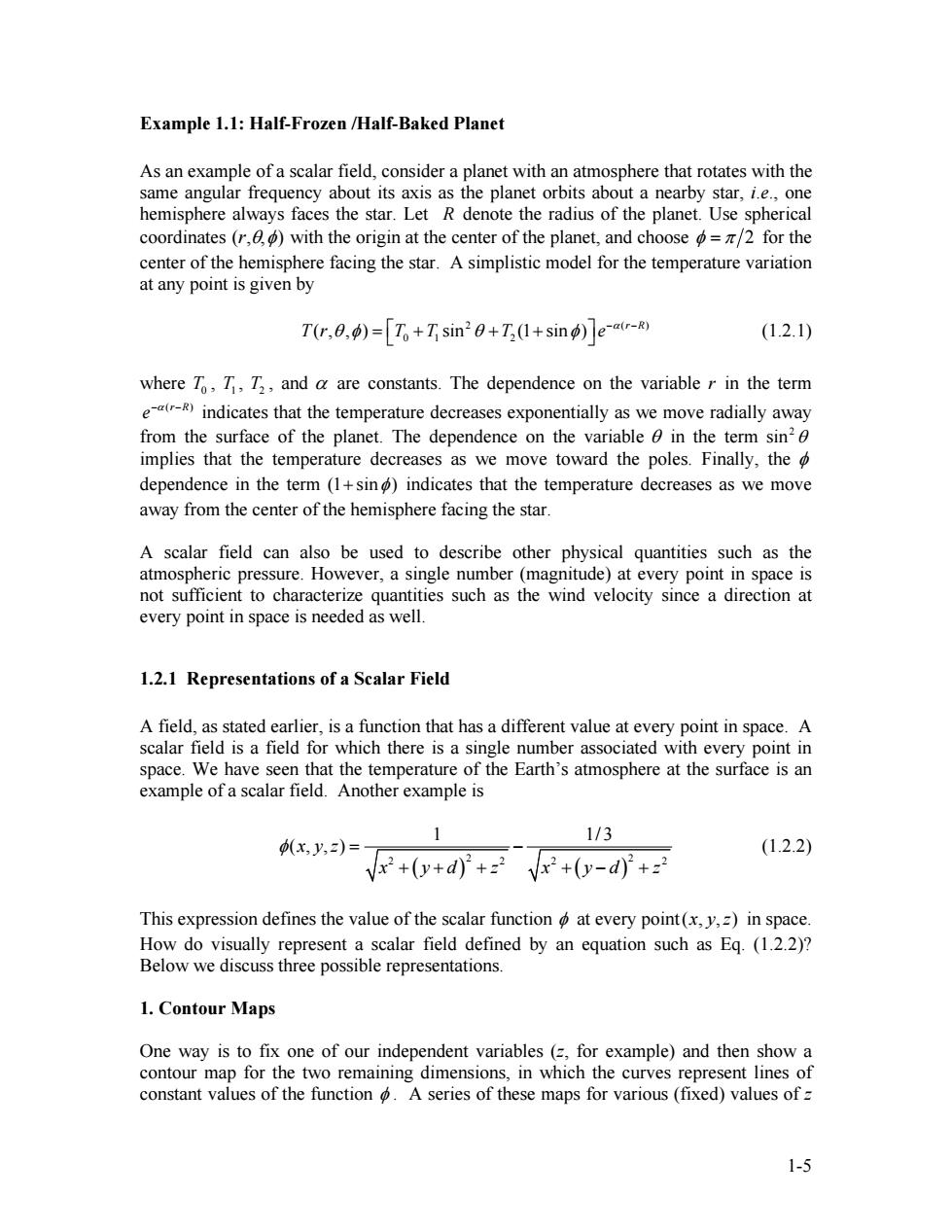
Example 1.1:Half-Frozen /Half-Baked Planet As an example of a scalar field,consider a planet with an atmosphere that rotates with the same angular frequency about its axis as the planet orbits about a nearby star,i.e.,one hemisphere always faces the star.Let R denote the radius of the planet.Use spherical coordinates (r,e)with the origin at the center of the planet,and choose =z/2 for the center of the hemisphere facing the star.A simplistic model for the temperature variation at any point is given by T(r,0,)=[T+Tsin0+(+sin)e-(-R) (1.2.1) where To,T,T2,and a are constants.The dependence on the variable r in the term eindicates that the temperature decreases exponentially as we move radially away from the surface of the planet.The dependence on the variable in the term sin2 implies that the temperature decreases as we move toward the poles.Finally,the dependence in the term(1+sin)indicates that the temperature decreases as we move away from the center of the hemisphere facing the star. A scalar field can also be used to describe other physical quantities such as the atmospheric pressure.However,a single number(magnitude)at every point in space is not sufficient to characterize quantities such as the wind velocity since a direction at every point in space is needed as well. 1.2.1 Representations of a Scalar Field A field,as stated earlier,is a function that has a different value at every point in space.A scalar field is a field for which there is a single number associated with every point in space.We have seen that the temperature of the Earth's atmosphere at the surface is an example of a scalar field.Another example is 1 1/3 (x,y,z)= (1.2.2) Vx+(y+d)2+2 Vx2+(y-d02+z2 This expression defines the value of the scalar function at every point(x,y,z)in space. How do visually represent a scalar field defined by an equation such as Eq.(1.2.2)? Below we discuss three possible representations. 1.Contour Maps One way is to fix one of our independent variables (for example)and then show a contour map for the two remaining dimensions,in which the curves represent lines of constant values of the function A series of these maps for various (fixed)values ofz 1-5
1-5 Example 1.1: Half-Frozen /Half-Baked Planet As an example of a scalar field, consider a planet with an atmosphere that rotates with the same angular frequency about its axis as the planet orbits about a nearby star, i.e., one hemisphere always faces the star. Let R denote the radius of the planet. Use spherical coordinates (r,θ,φ) with the origin at the center of the planet, and choose φ = π 2 for the center of the hemisphere facing the star. A simplistic model for the temperature variation at any point is given by 2 () 01 2 ( , , ) sin (1 sin ) r R Tr T T T e α θφ θ φ − − =+ + + ⎡ ⎤ ⎣ ⎦ (1.2.1) where T0 , T1 , T2 , and α are constants. The dependence on the variable r in the term ( ) r R e− − α indicates that the temperature decreases exponentially as we move radially away from the surface of the planet. The dependence on the variable θ in the term 2 sin θ implies that the temperature decreases as we move toward the poles. Finally, the φ dependence in the term (1 sin ) + φ indicates that the temperature decreases as we move away from the center of the hemisphere facing the star. A scalar field can also be used to describe other physical quantities such as the atmospheric pressure. However, a single number (magnitude) at every point in space is not sufficient to characterize quantities such as the wind velocity since a direction at every point in space is needed as well. 1.2.1 Representations of a Scalar Field A field, as stated earlier, is a function that has a different value at every point in space. A scalar field is a field for which there is a single number associated with every point in space. We have seen that the temperature of the Earth’s atmosphere at the surface is an example of a scalar field. Another example is ( ) ( ) 2 2 2 22 2 1 1/3 (, ,) xyz x yd z x yd z φ = − + + + +− + (1.2.2) This expression defines the value of the scalar function φ at every point(, ,) x y z in space. How do visually represent a scalar field defined by an equation such as Eq. (1.2.2)? Below we discuss three possible representations. 1. Contour Maps One way is to fix one of our independent variables (z, for example) and then show a contour map for the two remaining dimensions, in which the curves represent lines of constant values of the function φ . A series of these maps for various (fixed) values of z

then will give a feel for the properties of the scalar function.We show such a contour map in the xy-plane atz=0 for Eq.(1.2.2),namely, 1 1/3 (x,y,0)= (1.2.3) Vx2+y+d2Vx2+y-d0月 Various contour levels are shown in Figure 1.2.4,for d=1,labeled by the value of the function at that level. -2 0 Figure 1.2.4 A contour map in the xy-plane of the scalar field given by Eq.(1.2.3). 2.Color-Coding Another way we can represent the values of the scalar field is by color-coding in two dimensions for a fixed value of the third.This was the scheme used for illustrating the temperature fields in Figures 1.2.1 and 1.2.2.In Figure 1.2.5 a similar map is shown for the scalar field (x,y,0).Different values of (x,y,0)are characterized by different colors in the map. 0 2 0 21 Figure 1.2.5 A color-coded map in the xy-plane of the scalar field given by Eq.(1.2.3). 1-6
1-6 then will give a feel for the properties of the scalar function. We show such a contour map in the xy-plane at z = 0 for Eq. (1.2.2), namely, ( ) ( ) 2 2 2 2 1 1/3 ( , ,0) x y x yd x yd φ = − ++ +− (1.2.3) Various contour levels are shown in Figure 1.2.4, for d =1, labeled by the value of the function at that level. Figure 1.2.4 A contour map in the xy-plane of the scalar field given by Eq. (1.2.3). 2. Color-Coding Another way we can represent the values of the scalar field is by color-coding in two dimensions for a fixed value of the third. This was the scheme used for illustrating the temperature fields in Figures 1.2.1 and 1.2.2. In Figure 1.2.5 a similar map is shown for the scalar field ( , ,0) φ x y . Different values of ( , ,0) φ x y are characterized by different colors in the map. Figure 1.2.5 A color-coded map in the xy-plane of the scalar field given by Eq. (1.2.3)

3.Relief Maps A third way to represent a scalar field is to fix one of the dimensions,and then plot the value of the function as a height versus the remaining spatial coordinates,say x and y, that is,as a relief map.Figure 1.2.6 shows such a map for the same function (x,y,0). Figure 1.2.6 A relief map of the scalar field given by Eq.(1.2.3). 1.3 Vector Fields A vector is a quantity which has both a magnitude and a direction in space.Vectors are used to describe physical quantities such as velocity,momentum,acceleration and force, associated with an object.However,when we try to describe a system which consists of a large number of objects (e.g.,moving water,snow,rain,...)we need to assign a vector to each individual object. As an example,let's consider falling snowflakes,as shown in Figure 1.3.1.As snow falls, each snowflake moves in a specific direction.The motion of the snowflakes can be analyzed by taking a series of photographs.At any instant in time,we can assign,to each snowflake,a velocity vector which characterizes its movement. Figure 1.3.1 Falling snow. 1-7
1-7 3. Relief Maps A third way to represent a scalar field is to fix one of the dimensions, and then plot the value of the function as a height versus the remaining spatial coordinates, say x and y, that is, as a relief map. Figure 1.2.6 shows such a map for the same function ( , ,0) φ x y . Figure 1.2.6 A relief map of the scalar field given by Eq. (1.2.3). 1.3 Vector Fields A vector is a quantity which has both a magnitude and a direction in space. Vectors are used to describe physical quantities such as velocity, momentum, acceleration and force, associated with an object. However, when we try to describe a system which consists of a large number of objects (e.g., moving water, snow, rain,…) we need to assign a vector to each individual object. As an example, let’s consider falling snowflakes, as shown in Figure 1.3.1. As snow falls, each snowflake moves in a specific direction. The motion of the snowflakes can be analyzed by taking a series of photographs. At any instant in time, we can assign, to each snowflake, a velocity vector which characterizes its movement. Figure 1.3.1 Falling snow
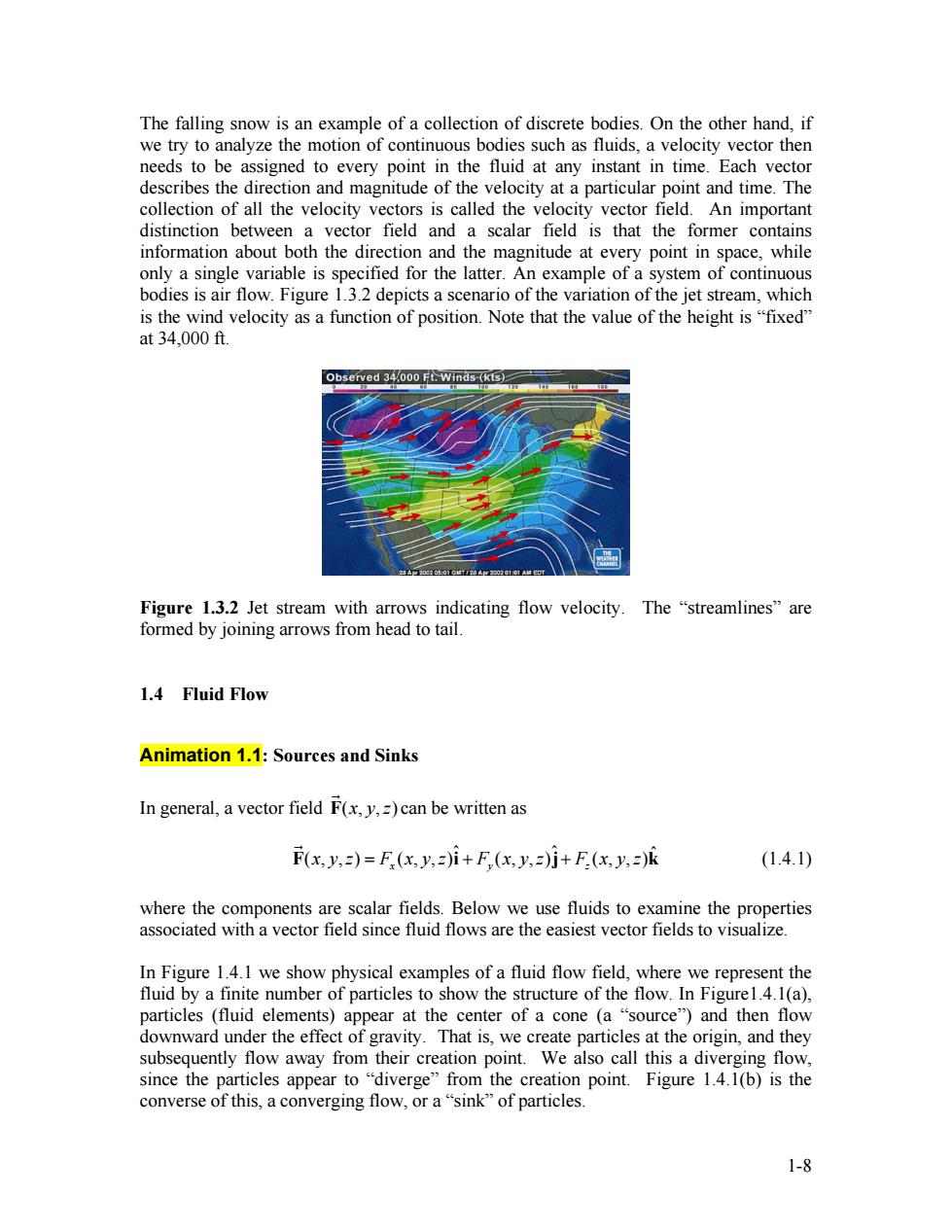
The falling snow is an example of a collection of discrete bodies.On the other hand,if we try to analyze the motion of continuous bodies such as fluids,a velocity vector then needs to be assigned to every point in the fluid at any instant in time.Each vector describes the direction and magnitude of the velocity at a particular point and time.The collection of all the velocity vectors is called the velocity vector field.An important distinction between a vector field and a scalar field is that the former contains information about both the direction and the magnitude at every point in space,while only a single variable is specified for the latter.An example of a system of continuous bodies is air flow.Figure 1.3.2 depicts a scenario of the variation of the jet stream,which is the wind velocity as a function of position.Note that the value of the height is "fixed" at34,000ft. Observed 34,000 Ft.Winds (kts) Figure 1.3.2 Jet stream with arrows indicating flow velocity.The "streamlines"are formed by joining arrows from head to tail. 1.4 Fluid Flow Animation 1.1:Sources and Sinks In general,a vector field F(x,y,)can be written as F(x.y,=)=F(x.y,=)i+F(x.y,=)j+F(x.y,2)k (1.4.1) where the components are scalar fields.Below we use fluids to examine the properties associated with a vector field since fluid flows are the easiest vector fields to visualize In Figure 1.4.1 we show physical examples of a fluid flow field,where we represent the fluid by a finite number of particles to show the structure of the flow.In Figure1.4.1(a), particles (fluid elements)appear at the center of a cone (a "source")and then flow downward under the effect of gravity.That is,we create particles at the origin,and they subsequently flow away from their creation point.We also call this a diverging flow, since the particles appear to "diverge"from the creation point.Figure 1.4.1(b)is the converse of this,a converging flow,or a "sink"of particles. 1-8
1-8 The falling snow is an example of a collection of discrete bodies. On the other hand, if we try to analyze the motion of continuous bodies such as fluids, a velocity vector then needs to be assigned to every point in the fluid at any instant in time. Each vector describes the direction and magnitude of the velocity at a particular point and time. The collection of all the velocity vectors is called the velocity vector field. An important distinction between a vector field and a scalar field is that the former contains information about both the direction and the magnitude at every point in space, while only a single variable is specified for the latter. An example of a system of continuous bodies is air flow. Figure 1.3.2 depicts a scenario of the variation of the jet stream, which is the wind velocity as a function of position. Note that the value of the height is “fixed” at 34,000 ft. Figure 1.3.2 Jet stream with arrows indicating flow velocity. The “streamlines” are formed by joining arrows from head to tail. 1.4 Fluid Flow Animation 1.1: Sources and Sinks In general, a vector field F(, ,) x y z G can be written as ˆ ˆ ˆ (, ,) (, ,) (, ,) (, ,) xyz F i x yz F xyz F xyz F xyz =++j k G (1.4.1) where the components are scalar fields. Below we use fluids to examine the properties associated with a vector field since fluid flows are the easiest vector fields to visualize. In Figure 1.4.1 we show physical examples of a fluid flow field, where we represent the fluid by a finite number of particles to show the structure of the flow. In Figure1.4.1(a), particles (fluid elements) appear at the center of a cone (a “source”) and then flow downward under the effect of gravity. That is, we create particles at the origin, and they subsequently flow away from their creation point. We also call this a diverging flow, since the particles appear to “diverge” from the creation point. Figure 1.4.1(b) is the converse of this, a converging flow, or a “sink” of particles
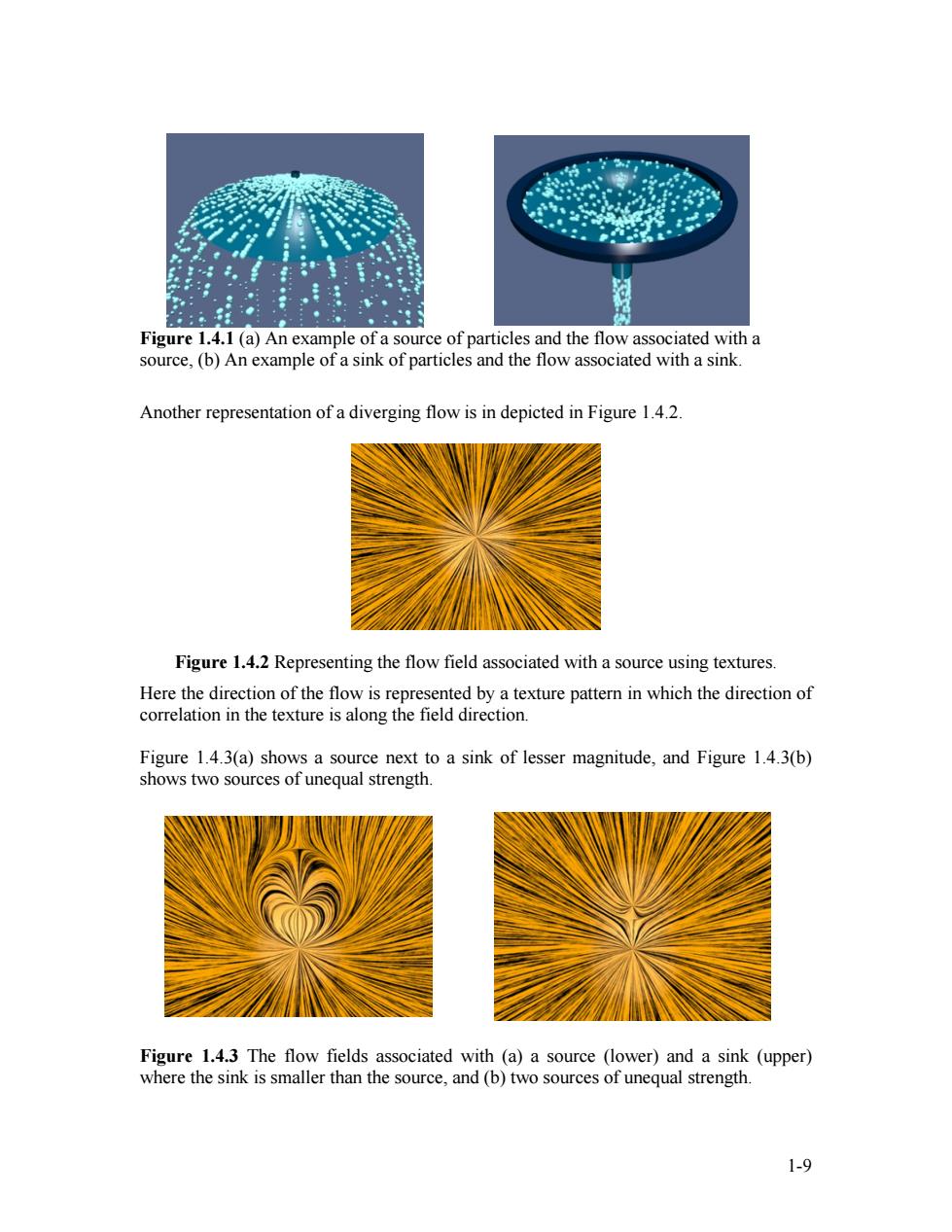
Figure 1.4.1 (a)An example of a source of particles and the flow associated with a source,(b)An example of a sink of particles and the flow associated with a sink. Another representation of a diverging flow is in depicted in Figure 1.4.2. Figure 1.4.2 Representing the flow field associated with a source using textures. Here the direction of the flow is represented by a texture pattern in which the direction of correlation in the texture is along the field direction. Figure 1.4.3(a)shows a source next to a sink of lesser magnitude,and Figure 1.4.3(b) shows two sources of unequal strength. Figure 1.4.3 The flow fields associated with (a)a source (lower)and a sink (upper) where the sink is smaller than the source,and (b)two sources of unequal strength. 1-9
Figure 1.4.1 (a) An example of a source of particles and the flow associated with a source, (b) An example of a sink of particles and the flow associated with a sink. Another representation of a diverging flow is in depicted in Figure 1.4.2. Figure 1.4.2 Representing the flow field associated with a source using textures. Here the direction of the flow is represented by a texture pattern in which the direction of correlation in the texture is along the field direction. Figure 1.4.3(a) shows a source next to a sink of lesser magnitude, and Figure 1.4.3(b) shows two sources of unequal strength. Figure 1.4.3 The flow fields associated with (a) a source (lower) and a sink (upper) where the sink is smaller than the source, and (b) two sources of unequal strength. 1-9
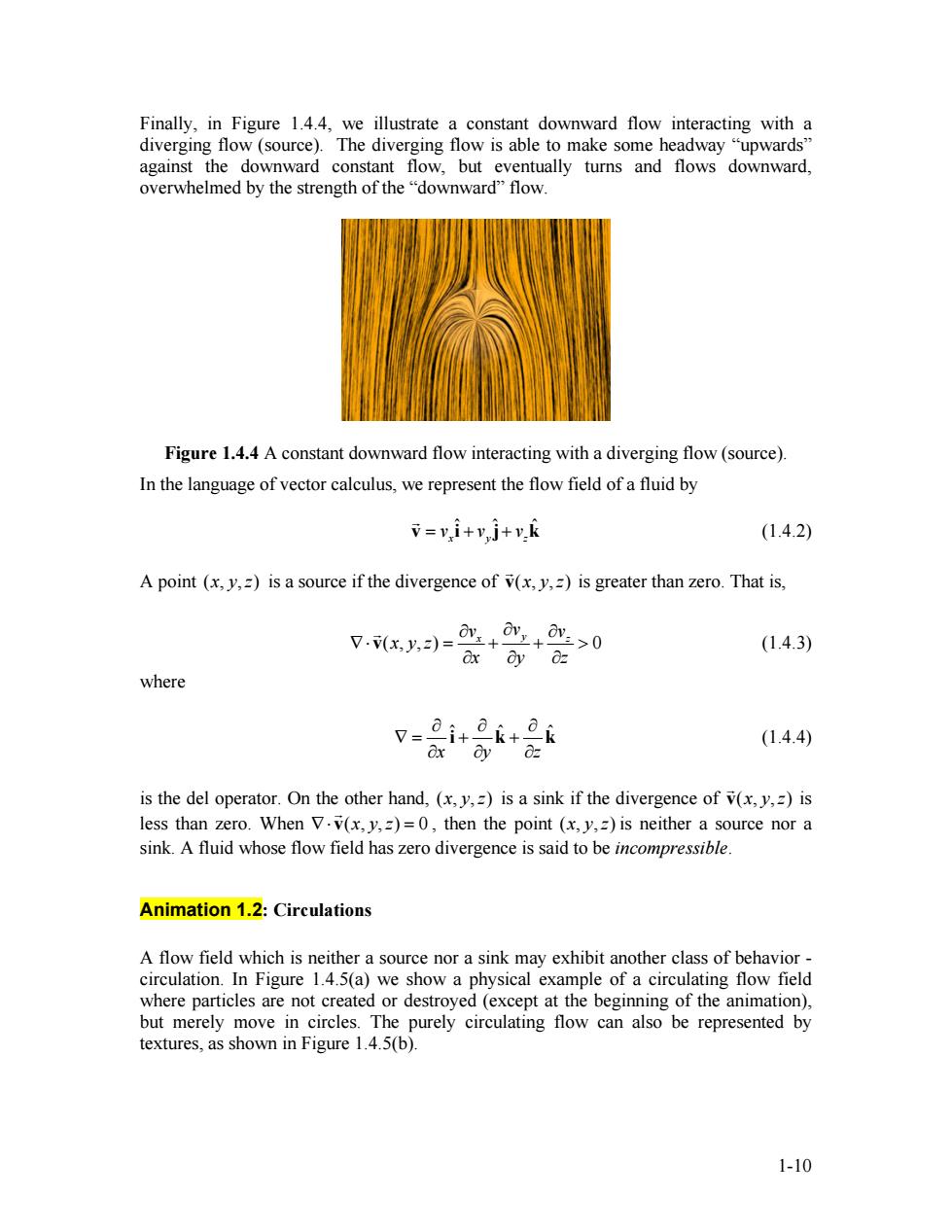
Finally,in Figure 1.4.4,we illustrate a constant downward flow interacting with a diverging flow (source).The diverging flow is able to make some headway "upwards" against the downward constant flow,but eventually turns and flows downward, overwhelmed by the strength of the "downward"flow. Figure 1.4.4 A constant downward flow interacting with a diverging flow (source). In the language of vector calculus,we represent the flow field of a fluid by V=vi+v,j+v.k (1.4.2) A point (x,y,z)is a source if the divergence of v(x,y,z)is greater than zero.That is, 7.xy)=++a>0 (1.4.3) ax dy Oz where =0i+k+ (1.4.4) is the del operator.On the other hand,(x,y,z)is a sink if the divergence of v(x,y,z)is less than zero.When V.v(x,y,z)=0,then the point (x,y,z)is neither a source nor a sink.A fluid whose flow field has zero divergence is said to be incompressible Animation 1.2:Circulations A flow field which is neither a source nor a sink may exhibit another class of behavior- circulation.In Figure 1.4.5(a)we show a physical example of a circulating flow field where particles are not created or destroyed (except at the beginning of the animation), but merely move in circles.The purely circulating flow can also be represented by textures,as shown in Figure 1.4.5(b). 1-10
1-10 Finally, in Figure 1.4.4, we illustrate a constant downward flow interacting with a diverging flow (source). The diverging flow is able to make some headway “upwards” against the downward constant flow, but eventually turns and flows downward, overwhelmed by the strength of the “downward” flow. Figure 1.4.4 A constant downward flow interacting with a diverging flow (source). In the language of vector calculus, we represent the flow field of a fluid by ˆ ˆ ˆ xyz v i =++ vvv j k G (1.4.2) A point ( , , ) x y z is a source if the divergence of ( , , ) v x y z G is greater than zero. That is, (, ,) 0 x y z v v v xyz xyz ∂ ∂ ∂ ∇⋅ = + + > ∂∂∂ v G (1.4.3) where ˆ ˆ ˆ x y z ∂ ∂ ∂ ∇= + + ∂ ∂ ∂ ikk (1.4.4) is the del operator. On the other hand, ( , , ) x y z is a sink if the divergence of ( , , ) v x y z G is less than zero. When ( , , ) 0 ∇⋅ = v xyz G , then the point ( , , ) x y z is neither a source nor a sink. A fluid whose flow field has zero divergence is said to be incompressible. Animation 1.2: Circulations A flow field which is neither a source nor a sink may exhibit another class of behavior - circulation. In Figure 1.4.5(a) we show a physical example of a circulating flow field where particles are not created or destroyed (except at the beginning of the animation), but merely move in circles. The purely circulating flow can also be represented by textures, as shown in Figure 1.4.5(b)